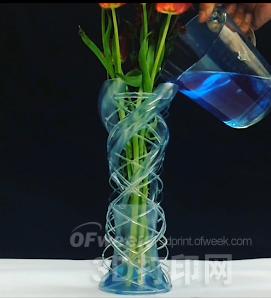The University of Lincoln in the United Kingdom is planning a 3D printed merchandise brand that will attract people of a certain age group to a "wrap-around" vase, which is only part of the Entangle, a high-end luxury household utensil brand for urban residents. The designer of the vase, Daniel Lane, told 3DPrint.com that the design inspiration came earlier than the process, and the final result was to create a vase. “I was inspired by DNA structure and leaf cell patterns and decided to use spirals and ascending structures as the beginning of the design.†Lane tells us, “After a few days of observation and thinking, I decided to identify the design model as a vase. This is more suitable for the range of luxury household utensils." Then, the idea of ​​letting water flow through the main body of the vase came into being. Lane first used the Rhino software, using the concept of the line, "tubular, gradual, and rotational" at different diameters and angles to create unique and overlapping tubes that ultimately create the main body of the vase. Then Lane discovered the potential characteristics that make the vase more unique. “After seeing more of this type of design, considering the connection of the vase to the brand name Entangle, I thought of letting the water interact with the vase body and making three spirals that later became hollow.†Lane explains Say. From an aesthetic point of view, this design allows the user to observe the flow of water through the overlapping tubes and eventually into the vase body. But another functional feature also comes from the original tubular basic design concept. After putting the flowers in the vase for a few days, the water level will drop and you will need to refill the water. Depending on the fullness of the vase, you must move the flowers frequently to refill the vase. However, the wrap-around vase removed this step, as the newly injected water flowed through the tube into the bottle, skipping the process of moving the flowers to the surface. In order to achieve the visualization of the flow of water through the tube, Lane decided to print the vase 3D using a transparent material. He chose to use iMaterialise's transparent resin to print vases using lithographic techniques. Although it is not possible to determine the printing time, a 1/3-size PLA material trial takes 7 hours, which can be used as a rough reference. The end result is fascinating, and Lane described the vase (water volume 350ml) as strong and elegant. “Although the vase looks weak,†he said, “but it is actually very strong, and each line is printed in a diameter that is aesthetically pleasing and strong enough to achieve overall stability.†The subtle balance that Lane achieves between design and function is a key feature of the wrap-around vase. Disposable Cleanroom Swab,Lint Free Cleanroom Swab,Cleanroom Polyester Head Swab ,Polyester Tip Cleanroom Swab Miraclean Technology Co., Ltd. , https://www.mrccleanroom.com
